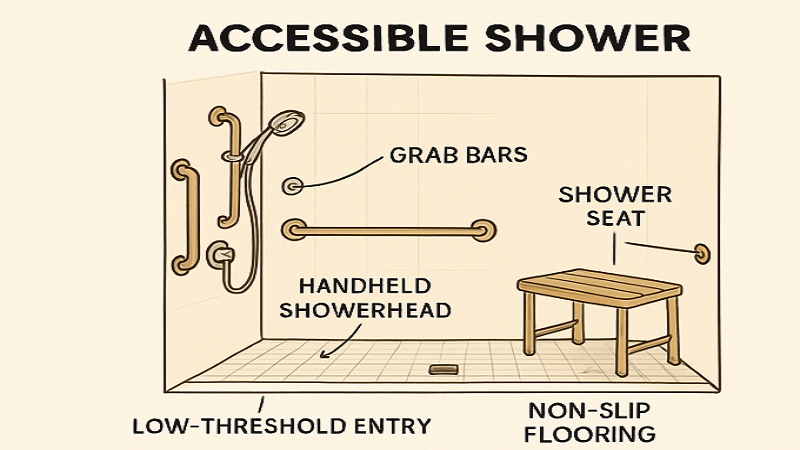Key Takeaways
- Accessible shower spaces can significantly improve the quality of life for people of all ages and abilities.
- Simple upgrades—like non-slip floors and easy-to-reach controls—can minimize falls and boost confidence.
- Modern design options mean accessibility and style can go hand-in-hand.
- Proactive planning today can support aging in place in the future.
- Customizable solutions exist for different needs, from walk-in showers to bench seating.
Table of Contents
- Why Accessible Showers Matter
- Essential Features of an Accessible Shower
- Incorporating Style With Safety
- Planning Ahead: Future-Proofing Your Home
- Easy Upgrades That Make a Difference
- Comparing Walk-In vs. Roll-In Showers
- Common Myths About Accessible Showers
- Where To Learn More
- Conclusion
Why Accessible Showers Matter
Creating an accessible shower space is more than just a home upgrade—it’s a proactive step toward safety and inclusivity. One out of four Americans aged 65 and older falls each year, and bathrooms are a common site for these injuries. Accessible shower spaces are designed to reduce such risks and help people remain independent longer. Accessible bathrooms aren’t just for seniors. They’re vital for people living with disabilities, multigenerational families, or anyone coping with injuries—temporary or permanent. Whether preparing for the future or adapting to a current need, considering solutions like walk-in shower installation services early can help maintain dignity and autonomy while minimizing hazards. Falls and slips in traditional bathrooms are preventable with the right upgrades. For families and caregivers, ensuring a safe, convenient space means peace of mind and an improved quality of life for everyone. This accessibility offers physical benefits and helps reduce anxiety around using the bathroom independently. Embracing accessible design is also a forward-thinking investment. With various products available, it’s easier than ever to craft a bathroom space that meets today’s needs and can evolve as they change. Planning for accessibility now can save significant costs and stress in the future.
Essential Features of an Accessible Shower
An effective accessible shower combines several must-have features to create a space that’s easy and safe for everyone. These typically include:
- Low-threshold or curbless entry:Allows easy access for individuals with mobility aids or who have trouble lifting their legs.
- Slip-resistant flooring:Minimizes the risk of slipping when the surface is wet.
- Grab bars:Installed near the entrance and within reach of the shower controls to provide support and stability.
- Adjustable or hand-held showerheads:These make bathing possible while sitting or standing and can be easily positioned based on user height or preference.
- Bench or fold-down shower seat:Provides a secure place to sit for those who tire easily or require additional support.
These features, grounded in universal design principles, ensure usability for people of all ages and abilities, eliminating the need for different adaptations as household members’ needs change.
Incorporating Style With Safety
Gone are the days when accessible meant unattractive or utilitarian. Today’s products allow homeowners to blend safety features with modern décor, so there’s no need to sacrifice style for function. Designers are integrating accessibility into elegant, spa-inspired bathrooms featuring sleek grab bars, frameless glass doors, and tile choices that offer texture and traction. For instance, large-format non-slip tiles, matte finishes, and stylish hardware tones like matte black or brushed gold can transform an accessible shower into a design statement. Trendsetting homes increasingly showcase thoughtful, inclusive layouts—with safety features camouflaged seamlessly within beautiful, inviting spaces.
Planning Ahead: Future-Proofing Your Home
Considering bathroom accessibility is a smart move, even if mobility challenges aren’t yet present in your household. According to research from the National Institute on Aging, designing for aging in place starts with assessing potential obstacles—and the bathroom is often the first place to upgrade.
Here’s a quick checklist for evaluating your current bathroom space:
- Is there a step or lip at the shower entrance?
- Do you have stable grab bars within reach?
- Is the lighting bright and glare-free?
- Are controls easy to operate with arthritic hands?
- Does flooring provide enough traction even when wet?
Planning proactively ensures that your home remains safe, welcoming, and valuable as your family’s needs change over time.
Easy Upgrades That Make a Difference
Creating a safer bathroom doesn’t always require a total renovation. Some impactful upgrades include adding shower seats or transfer benches, installing brighter LED lighting, swapping out fixed showerheads for handheld models, and applying non-slip treatments to the floor. Even adding a few grab bars can make a dramatic difference. Some changes can be tackled as a DIY project if you’re comfortable with basic tools. However, when making structural changes—like altering plumbing or widening doorways—it’s best to call in a professional contractor familiar with accessibility standards. Consulting an occupational therapist can also provide tailored recommendations for your household.
Comparing Walk-In vs. Roll-In Showers
Walk-in and roll-in showers both increase accessibility but come with distinct pros and cons. Walk-in showers typically have a low or zero threshold for easy entry and are suitable for most users, making them great for aging in place. Roll-in showers, by contrast, feature a fully level entry intended for wheelchair access—but require more floor space and often a more extensive renovation.
- Walk-in Showers:Efficient use of space, easier installation, works in smaller bathrooms, and is versatile for most households.
- Roll-in Showers arebest for full wheelchair access, comply with ADA standards, require more space, and are often more expensive upfront.
When choosing, consider household members’ current and possible future needs, as well as available space and budget.
Common Myths About Accessible Showers
Several misconceptions discourage homeowners from making helpful modifications. One common myth is that accessible showers look clinical or institutional. In reality, modern products blend invisibly into stylish bathroom designs. Some fear upgrades are prohibitively expensive, but many modifications—like installing grab bars or shower seats—are affordable and can be completed quickly. Another misconception is that accessible features reduce home value, yet market data shows buyers increasingly value aging-in-place upgrades, especially as multigenerational living increases in popularity. Inclusive design is now a sought-after asset, not a liability.
Where To Learn More
To deepen your knowledge, explore resources on universal design and aging in place, such as guides from the American Institute of Architects or the National Institute on Aging. Compare products, installation techniques, and design ideas before starting your project. Engage with local occupational therapists or accessibility-focused contractors for personalized advice. The right expert input can save time and ensure your shower upgrades meet your immediate and future needs.
Conclusion
Accessible showers strike the perfect balance between safety, style, and long-term practicality. By incorporating thoughtful features like slip-resistant flooring, grab bars, and curbless entryways, homeowners can create spaces that serve people of all ages and abilities. Today’s design innovations prove that accessibility doesn’t have to come at the expense of elegance—modern finishes and fixtures allow these upgrades to blend seamlessly into any aesthetic. Planning ensures that your home adapts gracefully to changing needs, supporting independence, comfort, and peace of mind. Whether adding minor upgrades or investing in a complete remodel, each step toward accessibility makes daily routines easier and safer. With the proper planning and resources, your bathroom can become a future-ready space that truly enhances quality of life.

